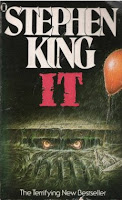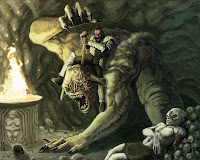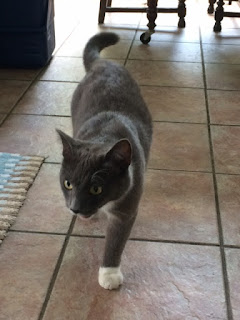With the recent premier of Stranger Things 2, I thought I'd take a moment to write about my favorite sub-genre. As far as I know it doesn't have an official name and even though there are several popular examples (especially from the 1980's and early '90's), few people think of it as an independent category. For lack of a better term I have dubbed it the "Cute/Funny Characters in Horrifying Situations" sub-genre
Examples:
(Loser's Club vs Evil Older Than Time)
(A different Losers Club vs. Dead Pirates)
(A lonely boy vs. Government Agents With Guns - or walkie-talkies, depending on which version you watch)

(Innocent elvish creature vs Dragon)
(Innocent elvish creatures vs. Nightmare Bird/Lizard Monsters)
(Dead children vs. Devilish Creatures In the Afterlife - at least in the middle third of this thousand page epic by Alan Moore.)
(Traumatized boys vs. Psychotic Gang Members - This novella, turned into the movie Stand by Me, isn't as fantastical as the other examples but it sets foot in the sub-genre. It's also just about the best thing Mr. King ever wrote.)
The Graphic Novel medium makes excellent use of this sub-genre.
(Three Small, Marshmallow-Like Creatures vs. Locust Monster and its Hooded Servant.)
(Three siblings and their friends vs. Evil Dwelling In Their House - This series was written by Stephen King's son, who I would argue is an even better writer than his father.)
(A Quiet, Polite Girl vs Every Sort of Evil Imaginable.)
And the examples go on and on to include: Ghostbusters, Buffy the Vampire Slayer, Gremlins, Harry Potter and of course Stranger Things.
All of these stories involve cute, funny or innocent characters (most of them are children or childlike) who find themselves in very severe danger. This danger is usually more horrific than similar heroes might face in other stories.
An example of a movie that comes close but doesn't quite make the category is Home Alone. The reason being that the burglars (Joe Pesci and Daniel Stern) are a part of the comedy. In fact they are more inept at being criminals than Macaulay Culkin's character is at taking care of himself.
Several of the examples I gave above include villains who are age-old forces of evil. All of the antagonists are good at what they do. Meanwhile the heroes are the ones who start out as inept or at least innocent. Had Home Alone's burglars been more like the criminals in Reservoir Dogs or if the house had been under attack by murderous ghosts (but Kevin remained a plucky/funny kid) then this comedy would make the list. Then again, it would have most likely not been a holiday blockbuster.
Some of the examples above weren't blockbusters but all have a devoted fan base who love the characters and relive the story over and over again.
So why do we like it when funny characters face off against demonic adversaries?
I once had a friend who claimed that books like It and movies like The Goonies provided a mean-spirited satisfaction to watch helpless children suffer in dark situations. Personally, I think this is a very pessimistic view on the sub-genre and it dismisses some very important aspects of storytelling.
One reason why we love these stories so much is because we always want a hero who starts out weaker than the villain. That's why heroes as capable as James Bond go up against governments or major terrorist organizations and why heroes as powerful as Beowulf go up against monsters and dragons.
However, many of the examples above widen that gap between hero and villain even further. Many of them take heroes who you might normally see facing bullies or a strict principal and puts them against villains who would normally be the adversaries of demon hunters.
On top of this, one thing people love is juxtaposition. We get a great deal of enjoyment out of comic relief in tense stories. In fact we often enjoy the jokes peppered throughout thrillers more than we enjoy many of the jokes in traditional comedies. Having a character who (at first) panics and reacts to the danger the way we would provides a great deal of opportunity to this comic relief. If done right comedy and horror go hand in hand very well.
We don't just react to the comedy or horror in these stories, we react to the sudden shift, moving us from one genre to the other. There are several traditional horror stories in which we become numb to the suspense or gore, like sitting in a jacuzzi for too long - you eventually become used to it.
However, the shift back and forth keeps things more interesting. The comedic aspects are funnier by comparison to the horrific elements and the horrific elements are more terrifying when compared to the comedic elements.
But there is an even deeper reason why we love this sub-genre. Most of us have never been demon hunters. Most of us will never be trained to fight the forces of darkness. However, we have all been children an adolescents. Buffy, It, Stranger Things and many other examples are about the metaphorical demons of childhood and growing up, which makes these stories so much more personable than if they had simply been about monsters.
We laugh when the scared/geeky kids scream because that is exactly how we would react. Later the story becomes all the more satisfying when the (physically) weak character defeats the age old evil. If you replaced the scared kid with someone who fights demons for a living you might still have an exciting, possibly even touching story but you will lose an important element.
Of course this sub-genre does have its drawbacks. Balancing comedy with tension is difficult. When it works it's great. When it fails it can be even more unpleasant than when a joke doesn't work in a traditional comedy.
One of the major drawbacks is that many people assume that - despite the MANY examples to the contrary - just because a story is about children then its target audience must be children. The Duffer Brothers have stated that when they were making Stranger Things they were told they either needed to make it a kid's show or take out the kids and focus on the police chief investigating paranormal events. While taking these suggestions may not have led to a horrible show, the end result would have most likely not been as much fun or unique as what we got.
Finally, this sub-genre simply isn't for everyone. While I would love to visit the dimension where they made Home Alone vs Reservoir Dogs, this movie would have most likely been a weird cult film along the lines of Heathers, not the family friendly mega-blockbuster it became.
The "Cute/Funny Characters in Truly Horrifying Situations" sub-genre (I really need to come up with a shorter name) is full of quirky, lovable and often relatable stories that don't just thrill us but also touch our own experiences. While many of these examples appeared in the 80's and early '90's, I am hoping that Stranger Things will introduce more people to the sub-genre and even more entries will appear in the future.





























